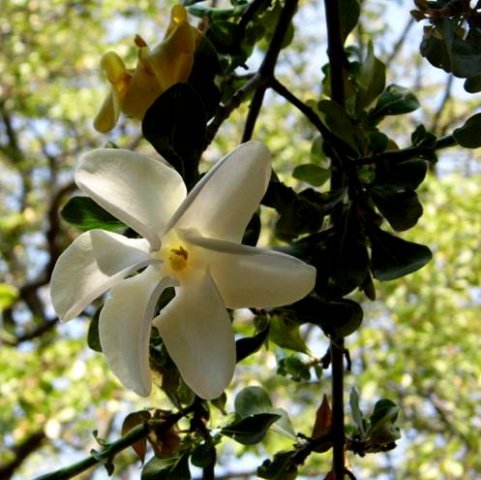Gardenia

Author: Ivan Lätti
Photographer: Eric Aspeling
Gardenia is a genus of evergreen shrubs and small trees in the Rubiaceae or coffee family, reaching heights from 1 m to 15 m. There are about 60 species in tropical and warmer parts of Africa, Asia, Madagascar and some Pacific Islands. Southern Africa is home to six of them. In South Africa gardenias are only indigenous in the eastern parts of the country, not the Western Cape or the Northern Cape.
The trees are unarmed, except for some that have rigid, sometimes spinescent tips on their smaller branches. New branchlets sometimes grow in whorls of three. Young plant parts are often sticky.
The opposite or whorled leaves are simple, growing on petioles flanked by ovate stipules that sheathe the leaf bases. The often dark green blades are thin to leathery, domatia sometimes present.
The flowers grow on short pedicels or are about sessile. They grow solitary or in corymb-shaped heads, often at the tips of side-branchlets. The buds may have glands that secrete wax. The cylindrical to bell-shaped calyx has five to eight lobes and is sometimes open to the base on one side.
The corolla has a long, cylindrical, funnel-shaped or bell-shaped tube and five to eight spreading lobes. These broad, variously shaped lobes may be contorted, overlapping to one side.
The five to eight stamens are attached inside the mouth of the corolla tube. They are either slightly exserted or included in the tube. The ovary comprises one or two chambers. The stigma is lance-shaped, club-shaped or two-lobed. The genus is known for the flower fragrance of many of its species.
The fruit is usually large and woody or leathery, covered by a thick outer wall. Its shape is globose, ellipsoid or ovoid, its surface ribbed or smooth. Many seeds are stuck together inside in a pulp. The seeds are elliptic and smooth.
The plant in picture is thought to be Gardenia ternifolia, photographed near the Kunene River, but also occurring in the north of Limpopo in South Africa (Leistner, (Ed.), 2000; Coates Palgrave, 2002; iNaturalist; Wikipedia).

